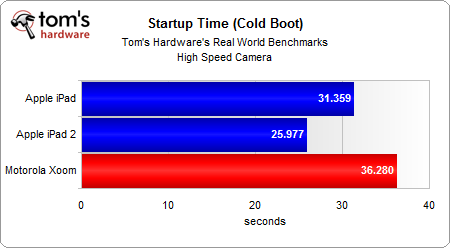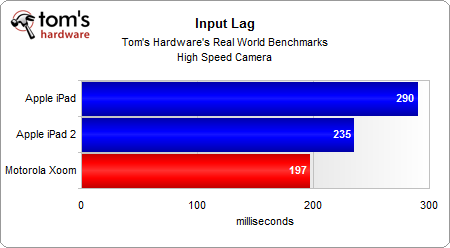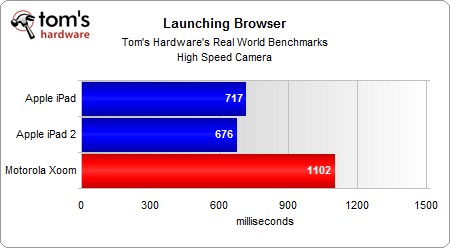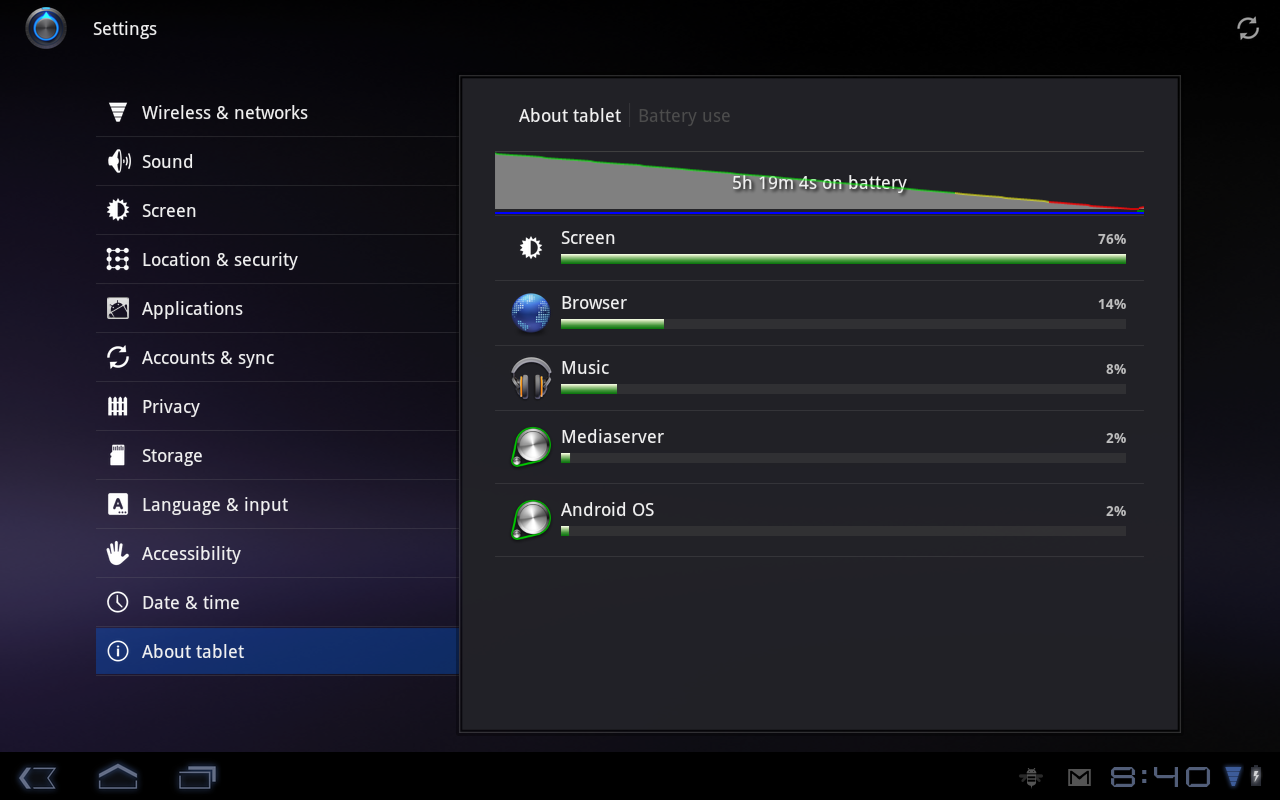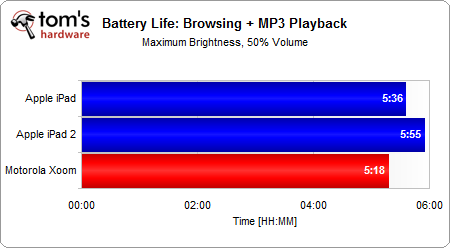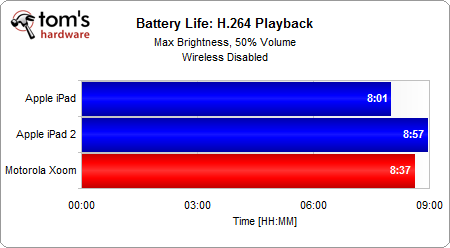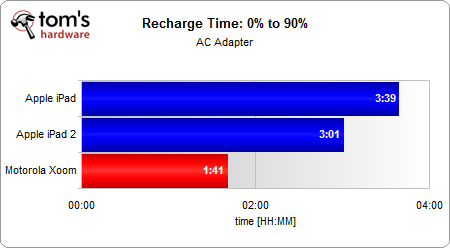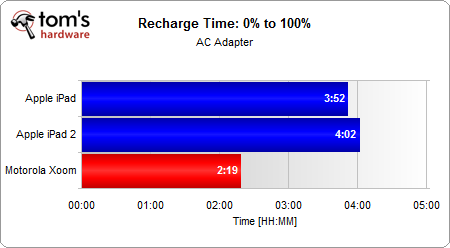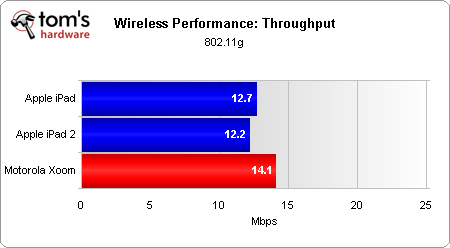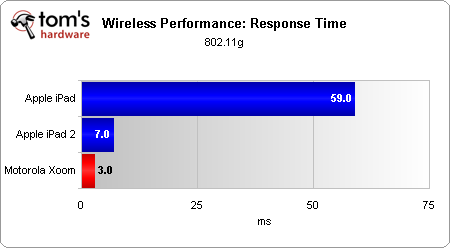Motorola Xoom: The First Android 3.1 (Honeycomb) Tablet
Real-World Performance And Battery Life
Real-World Benchmarks
Early on we discovered how difficult it is to benchmark tablets.
Benchmarking responsiveness with a camera is the fastest approach. Of course, normal cameras won't cut it, since they only shoot at 29 FPS. That's unacceptable if you're trying to measure precise time differences. Going the stop-watch route is no better due to human-introduced errors. That's why I'm using a 1000 FPS high-speed camera to measure performance. Since, 1 frame = 1 millisecond, it’s possible to measure timings with a high degree of accuracy.
The iPad 2 and Xoom employ the same CPU hardware, but the 10 second difference in boot-up time suggests that iOS is a fundamentally leaner operating system. When we look at browser launch times, the Chrome browser in Honeycomb definitely seems more boated than iOS's Safari, since the Xoom under-performs both iPads.
Input lag is the time that passed between pressing a key and text appearing on-screen. This tells you how fast the Xoom is registering an action. Ideally, you want low input lag so that you don't feel the tablet stuttering as you type or click on buttons. The average college student has a reaction time of 200 milliseconds for visual stimuli, so there's no perceptible lag while you're typing with the Xoom.
Battery Life
Testing a tablet’s battery life tends to be highly variable unless you control the entire experience from beginning to end. Cumulatively, touch gestures don’t have a great impact on battery life. The biggest factors are CPU/GPU processing, screen brightness, volume, and Wi-Fi use. In order to accurately measure battery life, I coded a script that automatically plays MP3s at 50% volume while browsing different Wikipedia pages every 12 minutes. This benchmark is probably overkill, but it gives you an idea of a worst-case scenario.
Get Tom's Hardware's best news and in-depth reviews, straight to your inbox.
Recharge Time
Charging times are a double-edged sword. Ideally, you want a nice slow charge so that your battery lasts more than a few hundred charges. Fast charge times keep you away from the wall socket longer, but in the long run it cuts down on the health of the battery. Usually, the rate of charge starts to slow down somewhere in the 80% to 95% range, which is why the charging time from 0% to 10% is faster than 90% to 100%.
Wireless Performance
It's wrong to look only at throughput to get a sense of network speed, because there are other factors that affect wireless performance. Latency, processing time, and the type of data being sent also affect the perceived "fastness" of a network connection.
Think of a phone call. Throughput is the audio quality. Latency is the amount of time from when you speak into the phone until the person on the other side hears you. And processing time is the delay as you think of a response to a question and speak into the phone. If we apply this to networking, throughput is the amount of data you can send over time, latency is the lag due to data transmission, while processing time is the overhead incurred by receiving the data.
| Load Web Page (seconds) | CNN | |
|---|---|---|
| iPad | 6.59 | 1.80 |
| iPad 2 | 5.85 | 1.53 |
| Xoom | 5.79 | 0.49 |
Now consider that latency plus processing time equals response time. This is where the Xoom holds an advantage over the iPad 2. Even though Motorola uses the same 802.11a/b/g Wi-Fi + Bluetooth 2.1 controller (Broadcom's BCM4329) as both iPads, the Xoom places a processing priority on network tasks, so it benefits from better response time and better throughput. However, Chrome seems to have a bigger processing overhead, so there's basically no speed advantage in Web page rendering.
Current page: Real-World Performance And Battery Life
Prev Page HDMI output And Camera Quality Next Page Final Words-
dragonsqrrl Very impressive review, especially the display quality page. A lot of in-depth information.Reply -
joytech22 Excellent! Covered everything I was interested in when comparing the iPad 2 to the Xoom.Reply -
tramit Excellent review. I also agree that the excuse of Android coming later in the game does not mean it cannot have the same growth in apps in the same alotted time frame that it was released.Reply
I personally feel that the iPad is a better device for gaming just by going through the app store and being able to find games ranging from Monopoly to FF3 and Infinity Blade. I have a Nexus S right now and the list of attractive games is not as long.
I like having both devices however. I plan to stay the course with continuing to purchase Android Nexus phones and having Apple supply me with their iPad. I get to enjoy the best of both worlds and not narrow my enjoyment of tech like most Droid and Apple fanboys. -
Maziar Excellent review.Reply
I'm impressed with the honeycomb but I think it has 2 major drawbacks
1)UI is somehow laggy and not 100% smooth
2)Lack of apps.
If these 2 issues get fixed,then we're going to see a better competition -
fstrthnu A little late, but very good quality review. Very nice to see custom benchmarks, it really shows you guys put in the effort here.Reply
I'd probably go for a Samsung Galaxy Tab 10.1, but that's just me. -
Seems HD video playback was not tested. Nice to have a HDMI option, but not really useful if most HD movies cannot play smoothly as is the case with the XOOM.Reply
Also, and probably related to the slow video, Tegra 2's CPU has no NEON extensions, limiting applications that use signal processing.
Yes, I do own a XOOM (also iPad 2 by the way) -
acku ReplySeems HD video playback was not tested. Nice to have a HDMI option, but not really useful if most HD movies cannot play smoothly as is the case with the XOOM.
Also, and probably related to the slow video, Tegra 2's CPU has no NEON extensions, limiting applications that use signal processing.
Yes, I do own a XOOM (also iPad 2 by the way)
Check out page 13. We tested H.264 battery life using a ripped 1280x720 Blu-ray movie.
On page 12, we also show HD playblack when you're mirroring the display.
@Everyone else. Thanks for the comments guys. If there's anything else you guy want to see in future reviews please let us know.
Cheers,
Andrew Ku
TomsHardware.com -
house70 Took quite a while to get this review done. Other tablets are already available that sport Honeycomb. Not to mention they are better than both contenders described in this article. I have a Transformer and no matter what I throw at it, it does it well. A review of that would be nice (maybe in another year or so...).Reply
Good effort, but as others have said, late to the table. -
house70 What the reviewer perceives as weaknesses, others perceive as strength. Example: the apps installation process. Not having to deal with iTunes is a bonus in itself, and having the option to make your own backups using whatever application you prefer is also a plus. The reviewer got a bit carried away by his personal bias towards iTunes/iOS environment. There are people that prefer to be led by hand while operating their tablet and there are others that prefer to pick and choose their options without limitations. It's a matter of personal preference. But this should not transpire into an objective review. Other than that, not too bad.Reply -
Wow - I couldn't disagree more with some of your views. Obviously you love you some Apple... I'm not an Apple hater - I have a Macbook Pro, I have an iPad, and I have a Xoom. I tell everyone the Xoom is 5X the tables the iPad is (Granted it's an iPad, not an iPad2 - but my beef with iPads are how much Apple controls what you can or can't do with it - that has not changed in the new generation of iPads). The iPad I can use as a toy, or as a cool media gadget - I actually basically gave it to my 6 year old son now bc that's all I can do with it. The Xoom I can use as so much more - it is was more useful on so many levels. Yes rendering takes a bit longer when you flip th screen, yes there are a few small quirks in it's behavior occasionally, but from an overall usefulness point of view I like it TONS betters than the iPad. Widgets - MultiTasking - OpenSource app development with an App store NOT controlled by Apple. Android IS the future for tablets. Apple needs to take note - they are just lucky at this point bc of their following, but Android will leave them in the dust. MS isn't even in the game and won't be even when Windows 8 hits. And you price comparison is off too IMO. $599 (now $499) for 32MB on the Xoom was in line (and is now better) than Apple's price point. Take it a step further and look the the Asus Eee Pad Transformer (very similar to Xoom with some things done even better) at $399. Android is taking hold, and will gain on Apple quickly, and eventually blow them away.Reply
